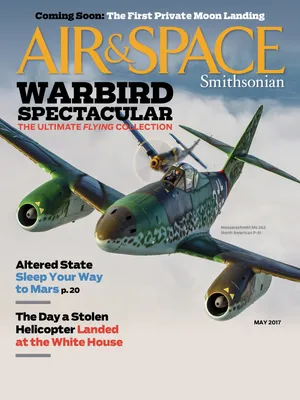Bob Pardo Once Pushed a Crippled F-4 Home With His F-4. In Flight.
…while in combat over Vietnam.
:focal(848x385:849x386)/https://tf-cmsv2-smithsonianmag-media.s3.amazonaws.com/filer/96/56/96560d2b-c968-4a86-873a-e95499bfd807/18a_am2017_pardowayneviaairportjournals_live.jpg)
The air strike that March day in 1967 was on the ferociously well-defended Thai Nguyen steel mill, north of Hanoi, North Vietnam. One of the attacking U.S. Air Force McDonnell F-4C Phantoms was hit twice by anti-aircraft fire, and gas was streaming from the fuselage. Pilot Earl Aman and weapons systems officer Bob Houghton no longer had enough fuel to return to safe territory.
The airplane Bob Pardo and backseater Steve Wayne were flying wasn’t in much better shape: During the strike it also caught an anti-aircraft round and was leaking fuel, and the two weren’t even sure they could reach an airborne tanker to refuel for the flight back to their base in Thailand. “But I couldn’t see leaving a guy I’d just fought a battle with,” Pardo says, so he radioed Aman, “I’m gonna try to give you a push. Fly that thing as smooth as you’ve ever flown.”
Pardo’s initial plan was to snug the nose of his F-4 against the tail of Aman’s so he could use the thrust of his two General Electric J79 engines to propel both stricken airplanes to the Laotian jungle, where rescue was a safer option. Pardo told Aman to jettison his tail parachute, in order to open a good push point at the rear end of Aman’s fuselage. “But there was so much turbulence coming off his airplane that I couldn’t even get within 10 feet of him,” Pardo recalls.
So Pardo went to Plan B. He maneuvered under Aman’s Phantom and inched upward in the hope that he could get the other airplane over the border piggyback-style. “When I got about a foot from him, the nose of my airplane started trying to come up, up, up. I thought, This is not good because we could smash our canopies, which would be a problem if we had to eject, which it looked like we were going to have to do because we were obviously getting low on fuel too.”
By this point Aman had shut down his engines, and his F-4 was descending at a rate of 3,000 feet a minute. But as Pardo reluctantly backed out from underneath the other airplane, he spotted the tailhook at the rear end of its fuselage. “Hell, that might work,” said Wayne, a pilot who later spent much of his flying career in F-106s. “Let’s give it a try.” So Pardo radioed Aman, “Put the hook down.”
Pardo placed the tail end of the hook’s steel rod against his windscreen and started pushing, which immediately halved the powerless Phantom’s rate of descent to 1,500 feet a minute. But it was not easy: The tailhook was designed to swivel from side to side, and worked its way free every 30 seconds or so. To make matters worse, the pressure of the tailhook against Pardo’s windscreen produced ominous spider-web-like cracks in the glass, so Pardo repositioned the tailhook against a section of metal at the base of the glass.
Then his left engine caught fire. Pardo immediately shut it down, but the loss of thrust increased the F-4’s sink rate to 2,000 feet a minute, and Pardo had to work overtime with the rudders. It didn’t look like they were going to reach Laos. So in a flagrant violation of normal procedure, Pardo restarted the engine and ran it until Wayne informed him the temperature gauge was pegged. After 10 more minutes, North Vietnam passed out of sight, and Aman and Houghton immediately ejected. Pardo’s right engine, starved of fuel, flamed out a few minutes later, and he and Wayne ejected as well.
Pardo’s Push, as the feat became known, had lasted for about 20 minutes and carried both jets 80 miles—far enough for a safe rescue.
Pardo, Aman, and Houghton injured their backs punching out, and all four airmen had to move to evade an approaching group of Laotian communist militia. Later, the aviators were extracted from the jungle by rescue helicopter crews. “When we got to the club, man, we couldn’t buy a drink,” Pardo recalls. “We had a pretty good party until about midnight.
“The next day, Steve and I went back to war.” The target? The same steel mill north of Hanoi.
